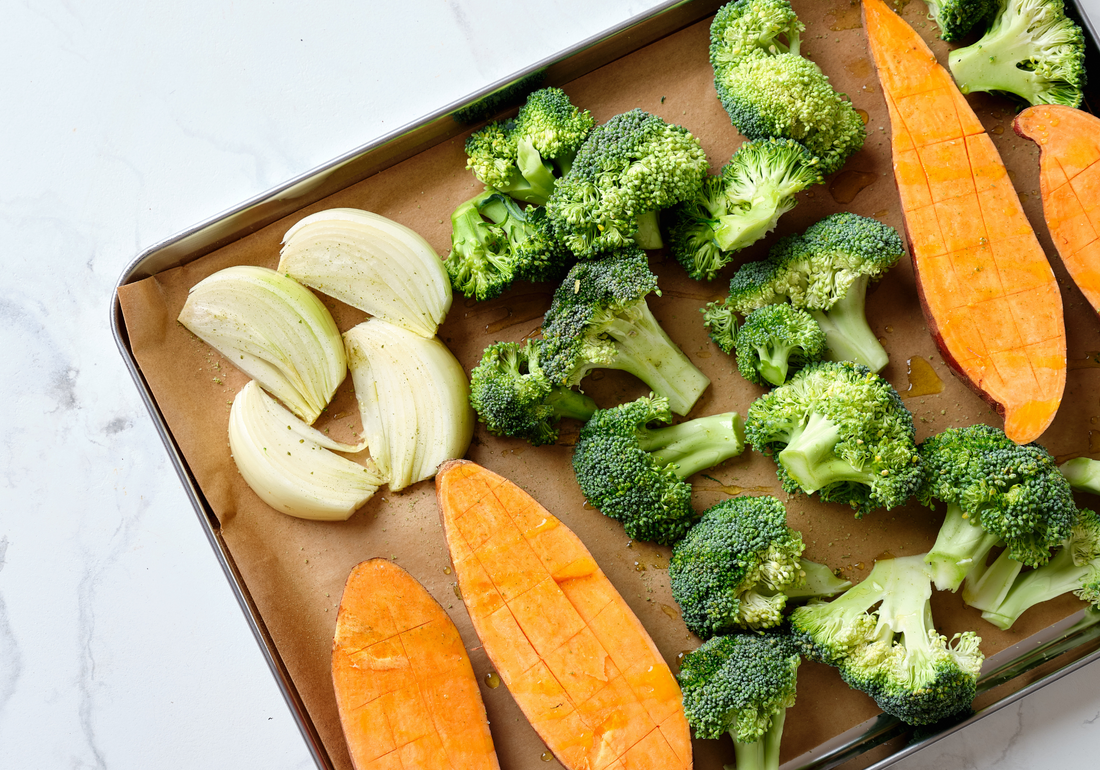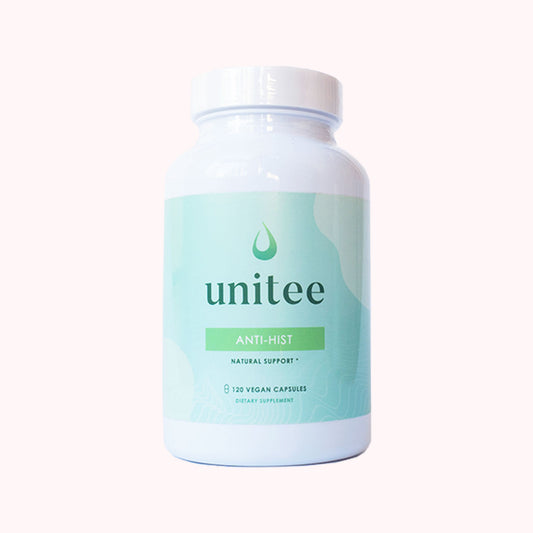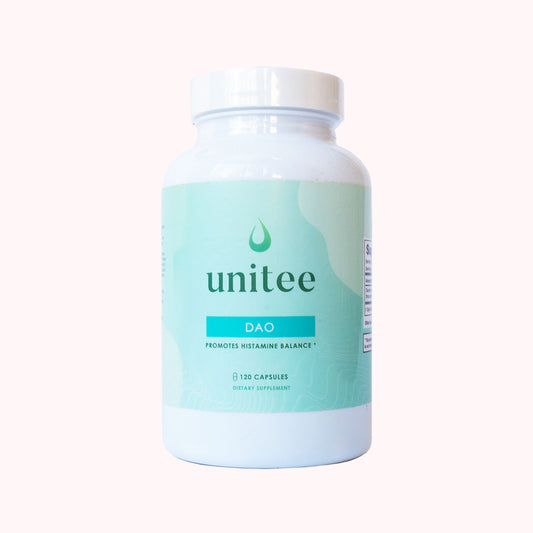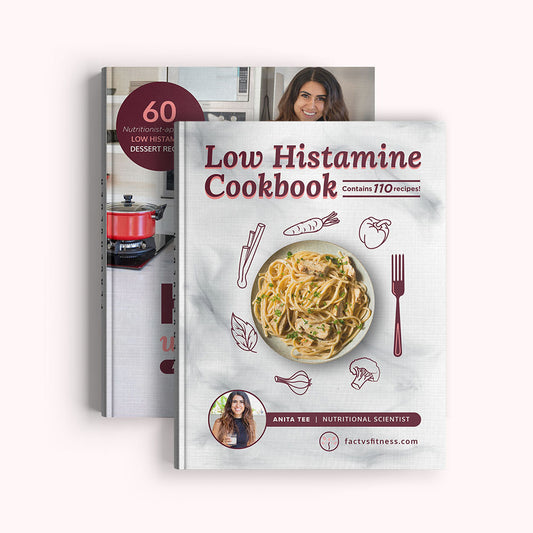If you’re a meal prep junkie, you’re likely making a few common mistakes that could seriously be damaging the nutritional content of your food, and I’m going to tell you how to fix them!
Can meal prepping impact histamine levels?
We all know why we meal prep – we’re busy, we’re rushed, we’re tired – all of these reasons and more make it inevitable that if you don’t plan ahead, you may end up scarfing down something that aggravates your symptoms out of pure starvation and easy access.
It's no secret that stress and histamine symptoms are linked, and chronic stress id definitely not good for our health. So, instead of putting ourselves in such a position, we prepare ourselves a homemade meal and `pack it away to get us through the day.
But has it ever occurred to you that Friday’s chicken, rice and veg may actually be nutritionally different and contain higher histamine levels when you eat it on Sunday?
It’s no secret that food doesn’t keep its nutritional contents forever, and unfortunately this means that by the end of the week your food might not be as nutritious as it once was, especially depending on your meal prep routine.
Where this comes into additional importance for our histamine intolerant people is that histamine levels can actually go haywire and make the same histamine-safe meal actually flare up your symptoms.
Additionally, nutrient deficiencies in histamine intolerance are common, so we want to avoid these as much as possible!
The first step, of course, is eating a low histamine diet - but, knowing how to eat and really how to prep your food so that you can make your life easier is of the utmost importance, too.
To get a free guide on what to eat and how to optimize your diet for histamine intolerance, click below.
Leftovers: why nutrients reduce and histamine increases

So I’m sure you’re all wondering how could the exact same lunch be less nutritious, higher in histamine. And, where did the nutrition go and where did that histamine come from?
The obvious way to consider this is to think of food spoilage – you wouldn’t eat food left in your fridge for weeks or months, and you’d probably get sick if you did. But this spoilage doesn’t happen overnight, and there’s actually a load of reactions occurring in the shorter term that result in altered nutrient values. So let’s take a look at what’s going on:
Food oxidation
Oxidation is a reaction that occurs when oxygen is able to access foods, and is often responsible for producing funky odors, flavours and colours1. Think of a sliced apple that turns brown – this is oxidation! Unfortunately, when foods oxidize, certain nutrients can lose their activity, and although this doesn’t necessarily mean the food is unsafe for consumption, it does mean that you may have lost a lot of the goodness that made your meal nutritious in the first place.

High histamine in leftover foos
Histamines are compounds most well-known for their involvement in inflammatory reactions. Think of someone you know who takes anti-histamines to control allergy symptoms. What most people don’t realize is that histamine also plays a role in several other disorders, with many people suffering with issues such as eczema, IBS, SIBO, urticaria, and even fibromyalgia showing to possess histamine sensitivities. Studies have shown histamine content to increase in foods over time2,3, and consuming leftovers can actually make the difference between feeling fine and having mild or even symptomatic inflammatory reactions in some individuals.
Microbial growths may contribute to dysbiosis and higher histamine
Microbes like food. Just as it does for us, food provides microbes with nutritional requirements necessary for growth and proliferation4,5,6. These microbes can be harmful themselves, or can participate in reactions that produce compounds which are unsafe for consumption. These factors begin proliferating before we can visibly notice and, if consumed, could contribute to negatively impacting your digestive processes by messing up the body’s natural bacterial balance, increasing your toxic load, or producing unwanted inflammatory responses.
Additionally, bacteria will convert the amino acid histidine into histamine, and leftover foods may therefore contain higher levels of histamine when consumed along with higher levels of bacteria that produce histamine within your body. It's very important to ensure you are not introducing high histamine bacteria into your body if you're histamine intolerant. So, even if you're using probiotics to help or prevent dysbiosis, it's important to check that you're only using low histamine probiotic strains.

Nutrient degradation
Nutrient degradation occurs over time, and is influenced by various factors, notably including the time and temperature of storage. Several studies have shown that heating storage methods influence nutrient contents including phytonutrients such as flavonoids and carotenoids, vitamins, minerals, etc.7,8,9 To exemplify this, just think of how much longer food stays fresh in the fridge. Luckily, storing food in the fridge or freezer and at an appropriate temperature is one of the simplest factors for you to control.
All of the processes above are naturally occurring, so are not easy to put to a complete stop. However, there are a few easy things you can do at home to slow down and minimize the negative impacts on your food.
Meal prep to reduce histamine and preserve nutrients
In a perfect world, I would of course tell you the solution is to go pick fresh vegetables from your garden and make a home-grown summer salad while slow-cooking fresh-caught fish from the river, but let’s get real. You’re busy, so I’m not going to take your meal prepping ways away from you.
What you can and should be doing however, is using a few simple meal prep techniques which will retain nutrient content and reduce oxidation and the probability of harmful exposures. This will allow you to optimize the balance between juggling your jam-packed life, minimizing your kitchen commitments, and maximizing your overall health and fitness.
Freeze meals to reduce histamine levels
One of the best ways to cut corners while maximizing nutritional preservation is by preparing chopped, ready-to-cook raw meals and freezing them. Once you arrive home, throw your bagged stir-fry in a pan, and by the time you’ve had a chance to change your clothes and wind down, dinner’s already ready. This technique is comprehensive enough to prevent microbial growths, oxidation and sharp histamine increases, while retaining way more nutrients than cooked and stored food.
Just be sure the food you are freezing is frozen from fresh - this technique will not work if you're freezing already aged food.
Use high quality air-tight storage containers to preserve nutrients and blunt histamine increases
Investing in sturdy, air-tight containers can help to prevent oxidation and microbial growths, maintain the appearance and taste of your meal, protect your nutrients and blunt any histamine spikes. Additionally, it’s important to consider that common food storage supplies, especially plastics and cling films, actually contain chemicals that can get absorbed by the foods you’re eating. Investing in high quality containers which are free of soluble chemicals, such as glass containers with an airlock, therefore also contributes to a strategy for reducing your body’s toxic load.
Keep temperature stable during transport to minimize histamine levels
As discussed above, temperature storage has a significant impact on nutrient degradation. Keeping your meals stored at a consistent temperature during transport, especially if you have a long commute, can significantly preserve nutrient content. Easy ways to minimize transport stressors include investing in a small cooler bag or thermal lunch box which will keep the temperature stable to minimize histamine levels and preserve nutrient content.
Reheat food the right way to preserve nutrients in and maximize health benefits
It’s widely known that heating food destroys certain nutrients10,11,12 – and doing it multiple times at high temperatures can destroy even more. Try and ensure you’re sticking to reheating your food as minimally as possible, only once and not too hot, or even adding in the vegetables raw and heating them for the first time when you consume the meal. This will decrease thermal stressors to optimize nutrient preservation.
Focus on low histamine foods and preparation methods
Above all, it's important to ensure the foods you are eating are low in histamine themselves but also foods that can act as natural antihistamines and help your body to keep histamine levels low as much as possible in order to reduce symptoms and allow your body the break it needs to begin healing. If you haven't already, I urge you to get my free low histamine diet guide which has a full foods list as well as guidance on how to optimize your diet and lifestyle in order to minimize symptoms.
So there you have it – 4 super simple ways to get more nutrition and minimize histamine levels while eating the same leftover foods!
Put your health in nature's hands.
Anita Tee, Nutritional Scientist
References
1. Löliger J. Headspace gas analysis of volatile hydrocarbons as a tool for the determination of the state of oxidation of foods stored in sealed containers. Journal of the Science of Food and Agriculture. 1990;52(1):119-128.
2. Rice S, Eitenmiller R, Koehler P. Biologically Active Amines in Food: A Review. Journal of Milk and Food Technology. 1976;5:322-375.
3. Bodmer S, Imark C, Kneubühl M. Biogenic amines in foods: Histamine and food processing. Inflamm res. 1999;48(6):296-300.
4. Remenant B, Jaffrès E, Dousset X, Pilet M, Zagorec M. Bacterial spoilers of food: Behavior, fitness and functional properties. Food Microbiology. 2015;45:45-53.
5. Doulgeraki ANychas G. Monitoring the succession of the biota grown on a selective medium for pseudomonads during storage of minced beef with molecular-based methods. Food Microbiology. 2013;34(1):62-69.
6. Zhao F, Zhou G, Ye K, Wang S, Xu X, Li C. Microbial changes in vacuum-packed chilled pork during storage. Meat Sci. 2015;100:145-49.
7. Hidalgo ABrandolini A. Kinetics of Carotenoids Degradation during the Storage of Einkorn ( Triticum monococcum L. ssp. monococcum ) and Bread Wheat ( Triticum aestivum L. ssp. aestivum ) Flours. J Agric Food Chem. 2008;56(23):11300-11305.
8. Achir N, Pénicaud C, Bechoff A, Boulanger R, Dornier M, Dhuique-Mayer C. Use of Multi-response Modelling to Investigate Mechanisms of β-Carotene Degradation in Dried Orange-Fleshed Sweet Potato During Storage: from Carotenoids to Aroma Compounds. Food Bioprocess Technol. 2013;7(6):1656-1669.
9. Ebner J, Baum F, Pischetsrieder M. Identification of sixteen peptides reflecting heat and/or storage induced processes by profiling of commercial milk samples. Journal of Proteomics. 2016;.
10. Campo M, Muela E, Olleta J, Moreno L, Santaliestra-Pasías A, Mesana M et al. Influence of cooking method on the nutrient composition of Spanish light lamb. Journal of Food Composition and Analysis. 2013;31(2):185-190.
11. Zhang J, Chen J, Ye X. Effect of three cooking methods on nutrient components and antioxidant capacities of bamboo shoot (Phyllostachys praecox C.D. Chu et C.S. Chao). Journal of Zhejiang University SCIENCE B. 2011;12(752).
12. Gerber N, Scheeder M, Wenk C. The influence of cooking and fat trimming on the actual nutrient intake from meat. Meat Science. 2009;81(1):148-154.







